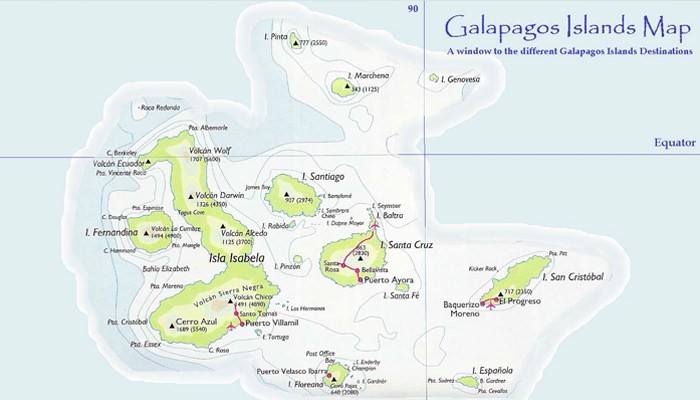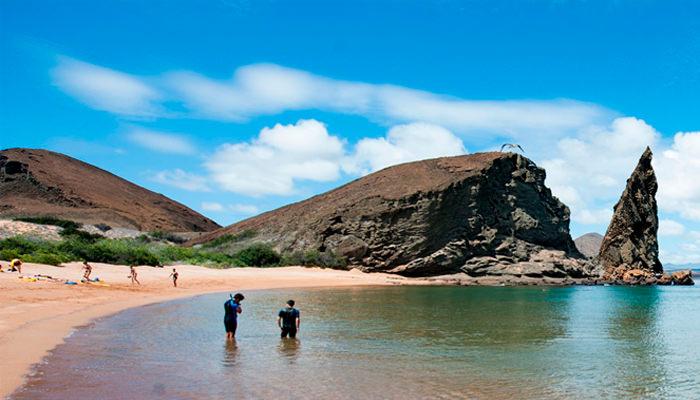Creation of galapagos islands
The Galapagos Islands, Ecuador, are an extensive group of volcanic islands situated on either side of Ecuador in the Pacific Ocean, 926 km west of the Ecuadorian coast. Specifically, this archipelago is located at the coordinates 1°40’N–1°36’S, 89°16’–92°01’W, and consists mainly of 18 main islands and 3 smaller islands.
Moreover, listed as one of the World Heritage Centers by UNESCO, the Galapagos Islands are very famous for their evolution and diversified flora and fauna. In fact, the endemic species of these islands were collected and researched by Charles Darwin, which contributed to his theory of evolution by natural selection.
Additionally, these islands and their surroundings form an Ecuadorian province, a national park, and a marine reserve. Notably, the principal language on the islands is Spanish. Undoubtedly, the creation of the Galapagos Islands is a matter of great fascination among travelers. To learn more, read a brief history below.
The Formation

The most unique thing about the Galapagos Islands is the way it has been formed. Let’s take a chronological look:
Located at the northern edge of tectonic plate called Nazca, continuous seismic and volcanic activities started at the sea floor and finally, landscapes emerged at the sea level.
Notably, the Nazca plate is surrounded by four other tectonic plates. To the north, it is bordered by the Cocos plate. Meanwhile, to the west, lies the Pacific plate. On the other hand, the South American plate is to the east, and lastly, to the south, is the Antarctic plate.
The Nazca plate drifted towards south, away from the Cocos, and east, away from the Pacific. Since the net direction of drift was southeast, the Nazca plate collided with the South American plate.
At the point of collision, the South American plate rided up over the Nazca plate. This type of plate interaction is called subduction.
As the Nazca plate is forced into the mantle, it melted and the plumes rose to the earth’s crust.
These plumes, though seemingly stable for millions of years, burnt to form an underwater volcano, which eventually grew bigger to give rise to an island.
Also, the plate being in constant motion, drifted away to make space for a similar volcano and finally, an island. As a result, a group of islands were formed.
This movement of the Nazca plate is responsible for creating the archipelago of volcanic islands, which are known as Galapagos Islands today.
Geographical Setting – creation of galapagos islands
Galapagos Islands, Ecuador consists of 18 main islands, which are:
Small and New Islands
- Baltra. It is a small flat island located near the centre of the Galapagos. It was created by geological uplift. The island is very dry and vegetation consists of salt bushes and prickly pear cacti.
- Bartolome. This is a volcanic islet just off the east coast of Santiago Island. It is one of the newer islands in the cluster. The green turtle is a famous animal that resides on this island.
- Genovesa. It has an area of 14 square km and a maximum altitude of 76 m. This island is formed by the remaining edge of a large caldera, which is submerged.
- Wolf. Also known as the Wenman Island, the Wolf Island was named after a German Geologist, Theodor Wolf. It is located about 100 miles northwest of the Isabela Island on the Wolf-Darwin Volcanic Ridge. The Darwin and the Wolf Islands are among the most remotely placed islands in the whole of the Galapagos Islands.
Galapagos Islands also include 3 minor islands, namely Daphne Major, South Plaza and Roca Redonda. - Pinta. Pinta, with the official Ecuadorian name, “Isle Pinta” was named after one of the three ships that sailed towards the New World of Columbia. It is the northern most among the large islands within the group. This island is the original home of the most famous Pinta Tortoise, Lonesome George.
Volcanic and Mountainous Islands
- Isabela. With an area of 4,640 square km, it is the largest island of the Galapagos. Its highest point is the Volcan Wolf, with an altitude of 1,707 m.
- Fernandina. Fernandina has an area of 642 square km and a maximum altitude of 1,494m. This is the youngest of all the islands.
Floreana – With an area of 173 square km and a maximum elevation of 640 m , it is one of the earliest islands to be inhabited. Flamingos and green sea turtles nest here. - Santiago. The Santiago Island was the second island that the great scientist Charles Darwin visited in 1835. It was then known to be a home for a large number of land iguanas. But, as time passed by, these are no more present on the Santiago Island.
Historic and Well Developed Islands
- San Cristobal. The San Cristobal Island, named after the Patron Saint of seafarers, St. Christopher, is the eastern most island among all the other Galapagos Islands. This is the fifth largest island among the group where Charles Darwin first went ashore in 1835.
- Santa Cruz. The second largest island of the Galapagos Islands, the Santa Cruz Island is located in the center of the archipelago. The name Santa Cruz means “Holy Cross”. Due to the invasion of humans on this island during World War I and World War II, this is the most developed island among all the others. The varied vegetation, ecology and wildlife attracted these people to come and settle here.
Unique islands and flora or fauna
- Darwin. With 168 m as its maximum altitude and an expanse of 1.1 square km, this island is named after the most famous visitor to the Galapagos Islands – Charles Darwin. This island plays host to marine iguanas, frigates, fur seals and red-footed boobies.
- Espanola. Its name was given as an honor to Spain. It has an area of 60 square km and a maximum altitude of 206 m. It is the oldest island at around 3.5 million years. It has its own species of lava lizard, mockingbird and tortoise.
- Rabida. The Rabida Island, also known as the Jervis Island, named after the British Admiral John Jervis is often considered to be the geographical center of the Galapagos Islands. The specialty of this island is the red sand found here. The island is a perfect spot for bird-watching as one will come across a number of bird species living in their natural habitat.
- Santa Fe. Located at the center of the archipelago and to the southeast of the Santa Cruz island, the Santa Fe island is also known as the Barrington Island. It is actually the oldest volcano with underwater rock formation that can be dated to some 3.9 million years back. It is a home to two endemic species called the Santa Fe, land Iguana and the Santa Fe Rice Rat.
Minor Islands
- Marchena. Deriving its name from Fray Antonio Marchena, it boasts of an area of 130 square km and has an optimum altitude of 343 m.
- North Seymour. A seismic event was responsible to lift the North Seymour Island above the waters. As it was originally a seabed, it still maintains its low and flat profile. Known as the largest nesting site for the magnificent Frigate Bird here in the Galapagos, the island also offers the sight of sea lions, marine iguanas and blue footed boobies.
- Pinzon. The Pinzon Island, situated at the center of the entire Galapagos archipelago, is known as a Devil’s Island as it has been dominated by rocks and spiny vegetation. Due to the absence of land and marine visitor sites, this island is one among the least visited one among the Galapagos Islands.
Weather conditions

Due to the Humboldt Current, the weather is quite cold in the Galapagos Islands, leading to drizzle showers during most of the year. However, the weather is periodically influenced by El Nino events. The sea temperature rises, which in turn cause the sea level to rise and trigger more wave action. The temperature ranges from 22 °C to 25 °C throughout the year in this archipelago.
Galapagos Islands, Ecuador are one of the unique and beautiful places to visit on earth. The pieces of lands formed due to solidified lava are now a home to many people, farming industries, forest reserves and a vast natural habitat.
Widely known as the living museum and showcase of evolution, Galapagos Islands have steadily climbed the preference charts of tourists who come from far and wide to this region where human presence is still kept to a minimum.
You don’t need to be an ornithologist or an evolutionary biologist to appreciate this place. You just need to soak the sights and sounds of this region. Which are matchless and have an old-world charm of their own.



Comments